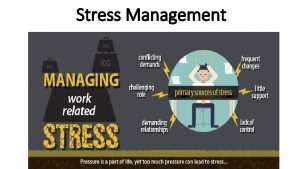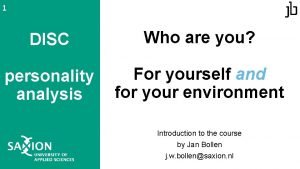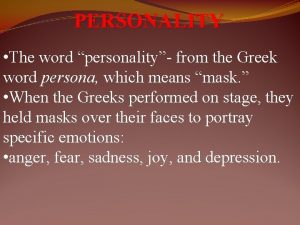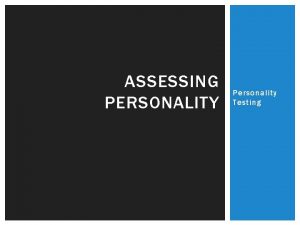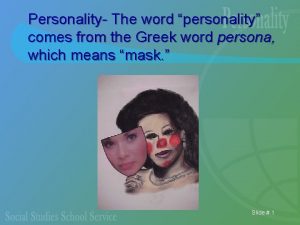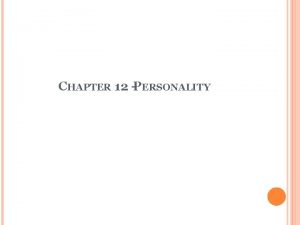DISC personality testing DISC Model Foundation comes from












- Slides: 12

DISC personality testing

DISC Model • Foundation comes from Harvard psychologist Dr. William Moulton Marston and his work in the 1920’s • He developed a theory that people tend to develop a “self-concept” based on one of FOUR factors • • DOMINANCE INDUCEMENT STEADINESS COMPLIANCE

Based on “Normal” Behaviors • To pictorially illustrate the DISC model, we represent the range of normal human behaviors and perspectives as a CIRCLE • “Normal human behaviors” means behaviors and perspectives derived from mainstream, healthy psychology • To effectively use the DISC model though remember NOTHING in the DISC model describes or discusses any type of psychosis, mental illness, or psychological abnormality

Drives • DISC model is based on how we react to two defining MOTIVATORS which tend to drive behaviors • Motor Drive • The “Pace” Drive • Compass Drive • The “Priority” Drive

Motor Drive (Pace Drive) • The Upper Half represents outgoing or fast-paced people • People here tend to: move fast, talk fast, and decide fast • The Lower Half represents reserved or slower-paced people • People here tend to: speak more slowly and softly, prefer to consider things carefully and thoroughly • REMINDER: THESE DESCRIPTIONS ARE tendencies NOT absolutes

Compass Drive (Priority Drive) • The Left Half represents task-oriented people • People here tend to: focus on logic, data, results, and projects • The Right Half represents peopleoriented people • People here tend to: focus on experiences, feelings, relationships, and interactions with people • REMINDER: THESE DESCRIPTIONS ARE tendencies NOT absolutes

Four Basic DISC Styles/Types • About 80% of people have two “high” DISC types • One is most likely higher than the other and is your PRIMARY style with the second one INFLUENCING the primary style • C/D means C is PRIMARY and D is INFLUENCING • 5% have only 1 “high” DISC type • 15% have TWO secondary types that influence their primary style

DOMINANT • People who have both OUTGOING and TASK-ORIENTED traits often exhibit dominant and direct behaviors • They usually focus on results, problem-solving, and the bottom-line

INSPIRING • People who have both OUTGOING and PEOPLE-ORIENTED traits often exhibit inspiring and interactive behaviors • They usually focus on interacting with people, having fun, and/or creating excitement

SUPPORTIVE • People who have both RESERVED and PEOPLE-ORIENTED traits often exhibit supportive and steady behaviors • They usually focus on preserving relationships and on creating or maintaining peace and harmony

CAUTIOUS • People who have both RESERVED and TASK-ORIENTED traits often exhibit cautious and careful behaviors • They usually focus on facts, rules, and correctness

 First comes love then comes marriage
First comes love then comes marriage Www.123 test.com/disc-personality-test/
Www.123 test.com/disc-personality-test/ Www.123 test.com/disc-personality-test/
Www.123 test.com/disc-personality-test/ 123 disc personality test
123 disc personality test Disc personality combinations
Disc personality combinations 16 source traits
16 source traits Pad foundation section
Pad foundation section Composition of urine
Composition of urine Domain testing example
Domain testing example Motivational overview of logic based testing
Motivational overview of logic based testing Du path testing
Du path testing Positive testing vs negative testing
Positive testing vs negative testing Static testing and dynamic testing
Static testing and dynamic testing

